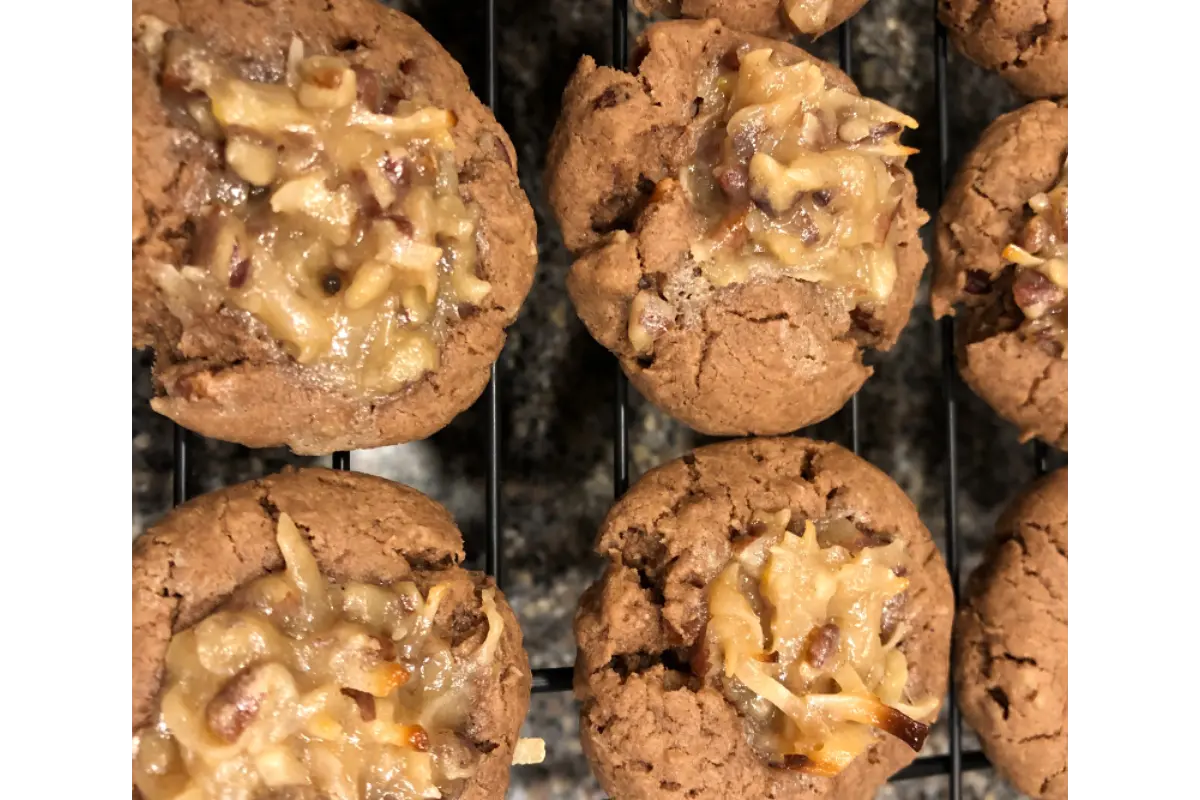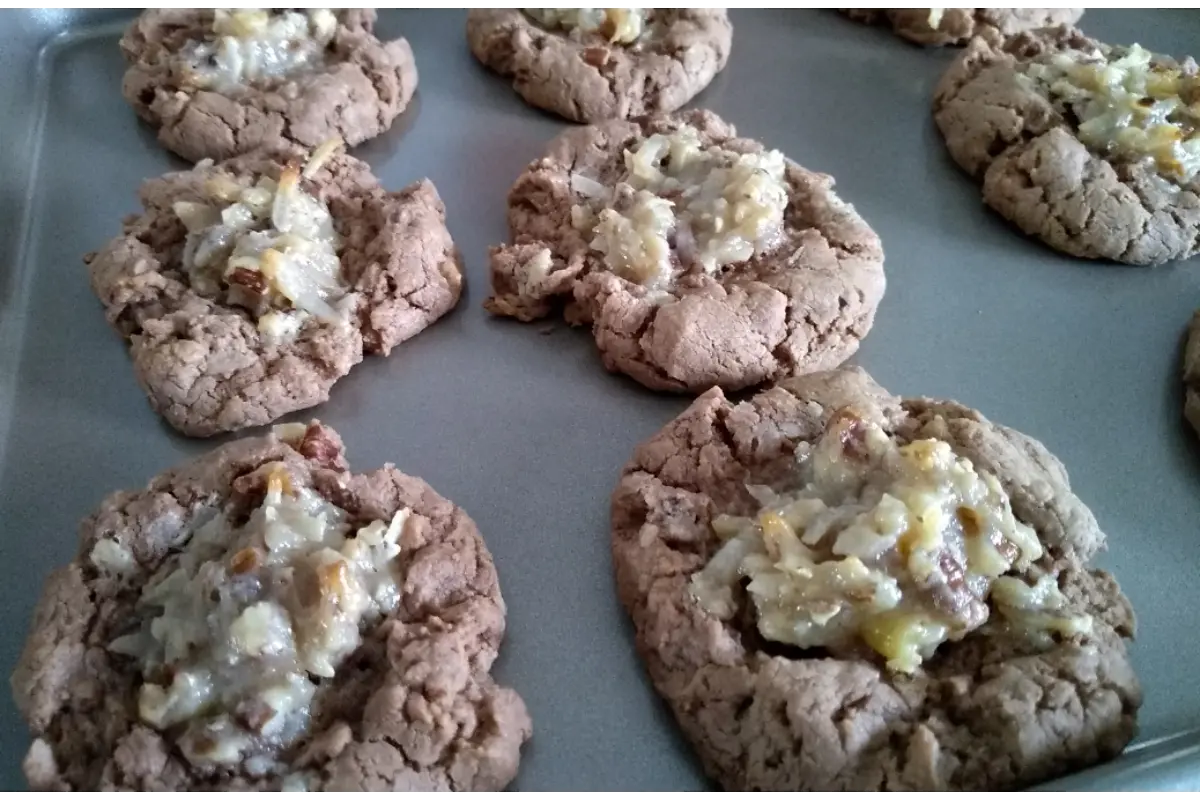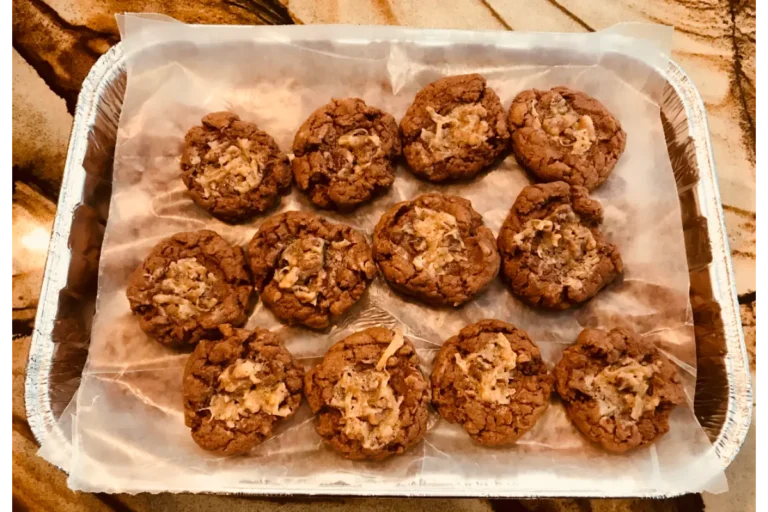Introduction to the Article
Embark on a delightful journey into the world of German Chocolate Cookies, a treat that offers more than just sweetness. In this comprehensive guide, we’ll explore every aspect of these cookies, from their rich history to the nuanced flavors that make them a favorite. We’ll also dive into practical baking tips, and delicious variations, and answer some of the most common questions bakers have about creating these delectable desserts. Ready your baking sheets and preheat your ovens—this guide promises to make you a master of German Chocolate Cookies.
Introduction to German Chocolate Cookies
Overview of German Chocolate Cookies
German Chocolate Cookies aren’t just a treat; they’re an experience. These cookies blend the rich flavors of smooth chocolate with the crunchy, nutty goodness of pecans and the tropical hint of coconut. It’s a combination that promises a burst of flavor with every bite, standing out in the world of sweets.
Importance in the Baking Community
In the baking community, German Chocolate Cookies are revered not just for their taste but also for their complexity and the skills they require to perfect. Baking these cookies offers a delightful challenge to both novice and seasoned bakers, allowing them to hone their skills in mixing, baking, and decorating. Moreover, the versatility of these cookies makes them perfect for various occasions, from casual gatherings to festive celebrations.
Crafting the perfect batch of German Chocolate Cookies involves a blend of traditional techniques and creative flair, making each baking session a new adventure. So, whether you’re a home baker looking to impress your family or a professional aiming to enrich your dessert menu, these cookies provide a canvas for your culinary artistry. As we proceed, you’ll learn not only how to make these cookies but also how to infuse them with your unique twist, ensuring that every batch is distinctly yours.
History and Cultural Significance
The Origin of German Chocolate
Despite what the name might imply, German Chocolate Cookies do not originate from Germany. Instead, they owe their name to an American baker by the name of Samuel German, who developed a type of dark baking chocolate for the Baker’s Chocolate Company. The chocolate, known as “Baker’s German’s Sweet Chocolate,” became popular in various recipes, one of which was the German Chocolate Cake, a precursor to our beloved cookies.
Introduction to German Chocolate Cookies
The transformation from cake to cookies is a testament to the adaptability and enduring popularity of this chocolate flavor profile. German Chocolate Cookies took the key elements of the cake—rich chocolate, coconut, and pecans—and reimagined them in a smaller, more convenient form. This innovation allowed for a more textured and nuanced experience, as the crunchiness of the pecans and the chewiness of the coconut could be more pronounced in the cookie format.
Today, these cookies are celebrated for their decadent taste and texture. They have become a staple in holiday baking and a favorite among those who appreciate a sophisticated twist on classic chocolate cookies. The cultural significance of these cookies lies not only in their delightful flavor but also in their ability to bring people together, making them a cherished part of gatherings and a beloved treat to share.
In the next section, we’ll delve into the ingredients that make up these exquisite cookies and the steps to preparing them, ensuring your baking is as enjoyable as it is successful. This part of the guide will equip you with all the knowledge needed to create these cookies with confidence and flair.

Recipe Ingredients and Preparation
Ingredients Overview
To embark on the baking adventure of German Chocolate Cookies, you’ll need a collection of key ingredients that come together to create a symphony of flavors. Here’s what you’ll need:
- All-purpose flour: The base of our cookies, providing structure.
- Unsweetened Dutch-process cocoa powder: For a deep, rich chocolate flavor. Penzey’s Dutch-process Cocoa Powder is a recommended choice for its quality and consistency.
- Baking powder and salt: To aid in rising and flavor enhancement.
- Butter: At room temperature, to ensure a smooth dough.
- Sugars: A mix of dark brown and granulated sugar for sweetness and moisture.
- Eggs: To bind the ingredients together.
- Vanilla extract: For an aromatic depth.
- Chocolate chips: Preferably semisweet, for those gooey chocolate pockets.
- For the topping: Evaporated milk, more sugar, butter, more vanilla, shredded coconut, and chopped pecans.
With these ingredients, each cookie turns out soft, chewy, and utterly irresistible. Ensuring each component is measured accurately is key to achieving the perfect texture and flavor balance.
Step-by-Step Preparation
Here’s how to put it all together to bake your German Chocolate Cookies:
- Preheat your oven to 350°F (177°C) and line your baking sheets with parchment paper or silicone baking mats to prevent sticking.
- Mix the dry ingredients: In a medium bowl, sift together the flour, cocoa powder, baking powder, and salt.
- Cream the butter and sugars: In a large mixing bowl, beat the butter with both sugars until light and fluffy. This introduces air into the batter, helping the cookies rise.
- Add the eggs and vanilla: Continue beating after each addition until the mixture is smooth and well incorporated.
- Combine the dry and wet mixtures: Gradually add your dry ingredients to the wet mixture, mixing until just combined. Overmixing can lead to tough cookies.
- Stir in the chocolate chips: Fold them in gently with a spatula to distribute them evenly without breaking them down.
- Shape the cookies: Using a cookie scoop, place dough balls onto the prepared baking sheets, spaced well apart to allow for spreading.
- Bake: Place in the oven and bake for about 10 minutes, or until the edges are just set but the centers are still soft.
- Prepare the topping: While the cookies bake, combine evaporated milk, sugar, butter, and egg yolk in a saucepan over medium heat. Stir constantly until thickened, then remove from heat and mix in vanilla, coconut, and pecans.
- Assemble: Once the cookies are baked and cooled, spoon the warm topping over each cookie and let set.
By following these steps, you’ll create a batch of German Chocolate Cookies that are delicious and a true showstopper in flavor and appearance. In the next part, we’ll explore baking techniques that can help elevate your cookies from good to extraordinary.
Baking Techniques and Tips
Baking Techniques
Perfecting your German Chocolate Cookies goes beyond following the recipe; it involves mastering a few key baking techniques that can significantly impact the final outcome.
- Temperature Control: Always ensure your oven is properly preheated before baking. An oven thermometer can help verify that the temperature is accurate, preventing underbaked or overbaked cookies.
- Parchment vs. Silicone: Use parchment paper or silicone baking mats on your baking sheets. These surfaces help to distribute heat evenly, avoiding the dreaded burnt bottoms.
- Chilling the Dough: If time allows, chilling the dough for at least 30 minutes before baking can prevent excessive spreading, resulting in thicker, more uniform cookies.
- Even Spacing: When placing dough balls on the baking sheet, leave enough space between them. This allows the cookies to spread without touching, ensuring even baking and perfect shape.
Professional Tips for Improved Texture and Flavor
Enhancing the texture and flavor of your cookies can make a big difference in the final product. Here are some professional tips to take your German Chocolate Cookies to the next level:
- Quality Ingredients: Opt for high-quality cocoa powder and chocolate chips, as these significantly influence the flavor and richness of your cookies. For instance, choosing Penzey’s Dutch-process Cocoa Powder ensures a deep chocolate taste.
- Butter vs. Margarine: Using real butter instead of margarine not only improves flavor but also affects how the cookies rise and develop texture.
- Do Not Overmix: Mix your dough just until the ingredients are incorporated. Overmixing can develop the gluten in the flour, leading to tough cookies.
- Underbaking Technique: Pulling the cookies out of the oven when they’re just set around the edges but still soft in the center gives them a gooey, soft texture after cooling.
- Customize Your Toppings: Experiment with the amount of coconut and pecans in the topping, adjusting according to your taste for more or less crunch and flavor.
By implementing these techniques and tips, you’ll not only ensure that your cookies turn out beautifully every time but also personalize them to your taste preferences. Next, we will explore the exciting variations and modifications you can apply to this recipe, allowing for even more creativity in your baking.

Variations and Modifications
Cookie Variations
The classic German Chocolate Cookies recipe is a fantastic starting point, but don’t be afraid to experiment and tweak it to cater to different tastes and occasions. Here are some exciting variations to try:
- White Chocolate and Macadamia: Swap the semisweet chocolate chips for white chocolate chips and replace pecans with macadamia nuts for a creamy, tropical twist.
- Mocha Pecan Delight: Add a teaspoon of espresso powder to the dough to infuse your cookies with a subtle coffee flavor that complements the rich chocolate and nutty pecans beautifully.
- Spicy Chocolate: Introduce a bit of heat by adding a pinch of cayenne pepper to the chocolate dough. This adds a surprising warmth that balances the sweetness.
- Salted Caramel Topping: Instead of the traditional coconut-pecan topping, try drizzling your cookies with salted caramel and a sprinkle of sea salt for a sweet and savory flavor profile.
Dietary Modifications
Catering to dietary restrictions doesn’t mean compromising on taste. Here are some modifications to help make German Chocolate Cookies more inclusive:
- Gluten-Free: Substitute the all-purpose flour with your favorite gluten-free flour blend. Make sure it’s a 1:1 baking blend to keep the texture as close to the original as possible.
- Vegan: Use plant-based butter and a flaxseed egg (1 tablespoon ground flaxseed mixed with 3 tablespoons water, set aside to thicken) in place of regular butter and eggs. For the topping, opt for coconut cream instead of evaporated milk and ensure your sugar is vegan.
- Lower Sugar: Reduce the granulated sugar in the dough by one-third and use a sugar-free alternative for the topping, or reduce its quantity to lessen the overall sweetness.
Each variation and modification lets you tailor the cookies to specific tastes and dietary needs. This ensures more people can enjoy this delightful treat. Whether you seek variety or need to meet dietary preferences, these tweaks allow everyone to enjoy a suitable version of German Chocolate Cookies.
Next, we will look at the nutritional aspects of these cookies, providing insights into their caloric content and tips on how to make them a bit healthier without losing their signature appeal.

